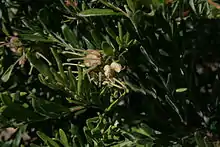Grevillea granulosa
Grevillea granulosa is a species of flowering plant in the family Proteaceae and is endemic to the south-west of Western Australia. It is a low, spreading shrub with linear leaves and red to orange flowers in clusters of up to eight.
| Grevillea granulosa | |
|---|---|
 | |
| In Burrendong Arboretum | |
| Scientific classification | |
| Kingdom: | Plantae |
| Clade: | Tracheophytes |
| Clade: | Angiosperms |
| Clade: | Eudicots |
| Order: | Proteales |
| Family: | Proteaceae |
| Genus: | Grevillea |
| Species: | G. granulosa |
| Binomial name | |
| Grevillea granulosa | |
Description
Grevillea granulosa is a compact to spreading shrub that typically grows to a height of 0.4–1.5 m (1 ft 4 in – 4 ft 11 in). Its leaves are linear, 35–160 mm (1.4–6.3 in) long, 1.2–2.5 mm (0.047–0.098 in) wide and silky-hairy, with the edges rolled under, enclosing most of the lower surface. The flowers are arranged in clusters of three to eight on a woolly-hairy rachis 0.5–6 mm (0.020–0.236 in) long. The flowers are red to orange, rarely yellow, the pistil 20–23 mm (0.79–0.91 in) long. Flowering occurs from July to October and the fruit is an oval or narrowly elliptic follicle 10–14 mm (0.39–0.55 in) long and ridged with a few shaggy hairs.[2][3]
Taxonomy
Grevillea granulosa was first formally described in 1986 by Donald McGillivray in his book New Names in Grevillea (Proteaceae), based on specimens collected by Alison Marjorie Ashby between Mullewa and Pindar in 1965.[4] The specific epithet (granulosa) means "abounding in small grains", referring to the leaf surface.[5]
Distribution and habitat
This grevillea grows in shrubland, mallee scrub, or woodland in the area between Wubin, Lake Moore and Yuna in the Avon Wheatbelt, Geraldton Sandplains and Yuna biogeographic regions of south-western Western Australia.[2][3]
Conservation status
Grevillea granulosa is classified as "Priority Three" by the Government of Western Australia Department of Biodiversity, Conservation and Attractions,[3] meaning that it is poorly known and known from only a few locations but is not under imminent threat.[6]
References
- "Grevillea granulosa". Australian Plant Census. Retrieved 3 May 2022.
- "Grevillea granulosa". Australian Biological Resources Study, Department of Agriculture, Water and the Environment: Canberra. Retrieved 27 April 2022.
- "Grevillea granulosa". FloraBase. Western Australian Government Department of Biodiversity, Conservation and Attractions.
- "Grevillea granulosa". APNI. Retrieved 3 May 2022.
- Sharr, Francis Aubi; George, Alex (2019). Western Australian Plant Names and Their Meanings (3rd ed.). Kardinya, WA: Four Gables Press. p. 210. ISBN 9780958034180.
- "Conservation codes for Western Australian Flora and Fauna" (PDF). Government of Western Australia Department of Parks and Wildlife. Retrieved 3 May 2022.
